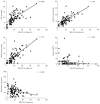Esophagogastric Junction Contractility Integral Reflect the Anti-reflux Barrier Dysfunction in Patients with Gastroesophageal Reflux Disease
- PMID: 27426485
- PMCID: PMC5216631
- DOI: 10.5056/jnm16008
Esophagogastric Junction Contractility Integral Reflect the Anti-reflux Barrier Dysfunction in Patients with Gastroesophageal Reflux Disease
Abstract
Background/aims: Anti-reflux barrier dysfunction is one of the primary mechanisms in gastroesophageal reflux disease (GERD) pathogenesis. The esophagogastric junction contractile integral (EGJ-CI) is a new metric adopted to evaluate the EGJ contractility, which implies the antireflux barrier function. The aim of the current study was to validate this new metric in patients with GERD and its correlation with the esophageal acid exposure, as well as the efficacy of proton pump inhibitor treatment.
Methods: Ninety-eight patients with GERD and 21 healthy controls were included in the study. Upper endoscopy, high-resolution manometry (HRM) and 24-hour multichannel intraluminal impedance-pH monitoring were performed in all patients. Three respiration cycles were chosen at the initial HRM resting frame and the value computed with distal contractile integral tool was then divided by the duration of the cycles to yield EGJ-CI. All the patients were treated with esomeprazole 20 mg twice-daily for 8 weeks.
Results: EGJ-CI was lower in the patients with GERD than that of the controls (P < 0.05). For patients with GERD, EGJ-CI was lower in those with hiatal hernia (P < 0.05). The new metric correlated with esophageal acid exposure in the supine position (P < 0.05), and it also negatively correlated to the total reflux episodes (P < 0.05). There was no significant difference on EGJ-CI between patients with and without response to the esomeprazole treatment (P = 0.627).
Conclusions: EGJ-CI reflected the dysfunction of the anti-reflux barrier in patients with GERD, but it had little impact on the esomeprazole response.
Keywords: Esophagogastric junction; Gastroesophageal reflux disease; Hernia, hiatal; Manometry; Proton pump inhibitors.
Figures


References
-
- Bredenoord AJ, Fox M, Kahrilas PJ, Pandolfino JE, Schwizer W, Smout AJ. Chicago classification criteria of esophageal motility disorders defined in high resolution esophageal pressure topography. Neurogastroenterol Motil. 2012;24(suppl 1):57–65. doi: 10.1111/j.1365-2982.2011.01834.x. - DOI - PMC - PubMed
-
- Nicodème F, Pipa-Muniz M, Khanna K, Kahrilas PJ, Pandolfino JE. Quantifying esophagogastric junction contractility with a novel HRM topographic metric, the EGJ-Contractile Integral: normative values and preliminary evaluation in PPI non-responders. Neurogastroenterol Motil. 2014;26:353–360. doi: 10.1111/nmo.12267. - DOI - PMC - PubMed
LinkOut - more resources
Full Text Sources
Other Literature Sources

